ATC Revisited: Margaret Rhee

Recap by KC Forcier, the 2019-2020 Graduate Liaison for the Art, Technology, and Culture Colloquium.
In Search of My Robot: Emergent Media, Racialized Gender, and Creativity
Poet, scholar, and BCNM alumnus Margaret Rhee spoke at the Art, Technology and Culture Colloquium last week, presenting work from her current book project, which provides a critical history of the robot as a locus of racialization for Asian Americans. “When does human end and cyborg begin, and where do we locate Asian American identity within this?” asks Rhee. The intertwining of the figure of the robot with Asian American representations is often deeply problematic, though Rhee’s research also points to moments when the robot operates as a means of racial resistance.
Rhee’s talk spoke eloquently to the theme of this year’s ATC series on “Robo-Exoticism.” Rhee recounts a cultural history of robots envisioned as immigrants from the future, as second class citizens. Through examples from literature and other pop cultural discourses, Rhee demonstrated how robots in American culture frequently “bear uncanny resemblances to the stereotype of Asian Americans as model minority.”
This history goes back to the mid-eighteenth century, when the Automaton Turk, an Orientalized chess-playing “robot” (actually a human disguised as a robot) toured America. However, as Rhee points out, “the Oriental Others in the US during this period were not Turkish but Chinese laborers.” Rhee’s research presents compelling examples of Chinese laborers during the latter half of the nineteenth century characterized as automatons, as machine-like sources of cheap, superhuman labor which threatened white workers. These stereotypes can be connected to the Chinese Exclusion Act of 1882 and subsequent racist policies.
Moving ahead to the 1960s, Rhee turned to a re-examination of the pioneering electronic artist Nam June Paik to consider one way in which the robot has served as a site for resisting or reworking racist stereotypes. By looking at the archive of Paik’s own writings on his robotic artworks in the 1960s, Rhee argues that race informed Paik’s work to a greater extent than is typically acknowledged. Rhee sees Paik’s robotic work as enacting a “tinkering,” or “hacking” of the historical racialization of Asian Americans, claiming the robot as a figure for humanizing Asian Americans. “Using technology as a tool of aesthetic and political intervention, Paik puts pressure on the human machine binary,” says Rhee.
With her scholarship as well as her teaching and her creative work as a poet and new media artist, Rhee advocates for such “tinkering” of binaries. She points to the need for alternatives to hegemonic systems, and the transformation of binaries - be it real/fake, human/machine, American/Other - through experimentation and imagination.

